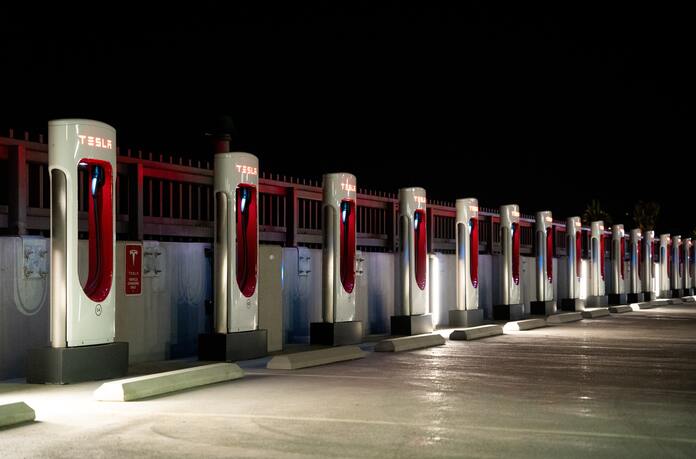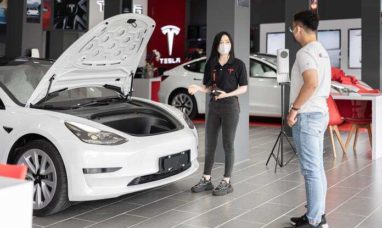Tesla Inc (NASDAQ:TSLA)
China is quite enthusiastic about electric automobiles. That is fantastic news for electric vehicle (EV) leaders Tesla and BYD, but China’s love for battery-powered cars also has significant repercussions for the United States market.
On Tuesday, the China Passenger Car Association (also known as the CPCA) announced the auto stats for the month of February. In reality, sales of passenger vehicles are approximately 16% lower than they were this time last year. Purchases of automobiles are decreasing.
Electrified vehicles are not subject to this limitation. The first two months of this year have seen a rise of 23% in the number of sales of new energy vehicles, also known as NEVs. Data about electric vehicles in China are reported using NEV. The phrase refers to plug-in hybrids as well as battery electric vehicles (EVs), such as the ones manufactured by Tesla (NASDAQ:TSLA).
When the sales of electric vehicles are subtracted from the total in China, the year-over-year decline in sales of gasoline-powered vehicles is found to be 25% in the first two months of 2023.
The market for automobiles that are fuelled by gasoline is seeing a precipitous decline.
In China, EV Sales Are Soaring
Yes, that’s correct. In China, the number of people purchasing electric vehicles (EVs) has been quickly growing over the past several years. In 2020, China sold 1.37 million new energy vehicles, which include pure electric vehicles and plug-in hybrids, an increase of 11% from the previous year. This occurred despite a slump in overall auto sales caused by the COVID-19 pandemic. The data was provided by the China Association of Automobile Manufacturers (CAAM).
The electric vehicle market in China is the largest in the world, accounting for over half of all EV sales worldwide. Via a variety of subsidies, tax exemptions, and other incentives, the Chinese government has been actively working to encourage the widespread use of electric vehicles. The government has established a target date of 2025 to achieve its goal of having new energy vehicles account for 20% of total sales of new cars.
The rise in sales of electric vehicles in China can be attributed to a number of different factors, including the regulations of the Chinese government, the desire of Chinese consumers for cleaner automobiles, and advancements in EV technology. Meanwhile, China is home to a number of major electric vehicle (EV) manufacturers, such as BYD, NIO, and Li Auto, all of which are engaged in a cutthroat battle for market dominance.
In the month of February, Chinese customers purchased over 439,000 new energy vehicles (NEVs), which represented roughly 32% of all passenger vehicles sold. In the first two months of this year, the percentage of all passenger vehicles sold that are alternative fuel or electric vehicles has reached roughly 29%.
From some perspective, during the months of January and February in China, around 770,000 new energy vehicles (NEVs) were sold. It is estimated that over 930,000 battery EVs and plug-in hybrid vehicles were sold in the United States throughout the entirety of 2022.
By a significant margin, the market for electrically powered automobiles is most robust in China. Around 6% of the total number of cars sold in the United States in 2022 were battery-electric vehicles. The vast majority of auto manufacturers think that will continue to rise. And reaching a 30% or 40% market share in the United States during the next five years is essential to the goals of Tesla, General Motors (NYSE:GM), and Ford Motor Company (NYSE:F). Tesla solely makes EVs. Both General Motors and Ford have committed tens of billions of dollars to the development of electric vehicles (EVs) with the hopes of selling millions of EVs annually by the end of this decade.
The situation in China’s automobile sector demonstrates that that is most likely the best method.
About Tesla, throughout the month of February, it sold 33,923 units within the United States and exported 40,479 units from its plant in Shanghai. The number of domestic sales came in almost 2,000 units higher than the numbers that were suggested by the data on insurance registration kept track of by Wall Street analysts.
Tesla’s electric vehicle (EV) sales in China for the months of January and February climbed by 43% year over year, which was a quicker growth rate than the market overall. This indicates that Tesla gained market share in 2023. In January, Tesla made price reductions across its product line in China, and the move was successful.
However, Tesla services not just the Chinese market but also the European market from Shanghai, which makes calculating month-to-month market share less meaningful. Tesla was able to secure approximately 8% of the overall NEV market. If plug-in hybrid vehicles are not included, Tesla has around 11% of the market share.
In the first two months of 2023, sales of battery-electric vehicles at BYD (1211. Hong Kong) increased by 80%. It gained a significant amount of market share, accounting for approximately 28% of the market for battery-electric vehicles.
Yet, most of the company-specific statistics were revealed earlier in the month. The CPCA numbers indicate to investors something crucial about the direction of the global auto market, but the majority of those numbers were already known. There is no surprise in store for the stock market this Wednesday.
In premarket trading on Wednesday, Tesla stock experienced a loss of 1.3%. Futures contracts for the S&P 500 (SPX) and the Nasdaq Composite (COMP) are now trading at no change. During trading in outside markets, BYD shares had a decline of 2.9%, while the Hong Kong market overall declined by 2.4%.
Featured Image: Pexels @ Soly Moses









